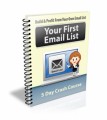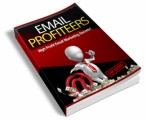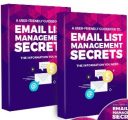Sample Content Preview
Combining Them
Ideally, a solid email marketing strategy will use a combination of newsletters and autoresponder sequences. At a minimum, you should have one robust welcome sequence in which you familiarize your subscriber with your brand, instruct them to white-list your email address and follow you on social, share your most popular helpful content, and anything else you think would help your business and your subscribers. Ideally, after that, you’d put them through at least a few cross-selling emails in which you introduce them to some of your own products or some affiliate offers (e.g. a “what we use” series might be a good way to help them by showcasing the tools you use in your business and earn some commissions at the same time if they decide to try those tools too). Once your autoresponder sequences are done, then it makes sense to drop your subscribers into a general pool of contacts who will simply receive your real-time newsletters from that point forward.
Frequency
A lot can be said about email marketing frequency. It’s an area that divides marketers quite a bit. Generally, there are two opposing schools of thought plus a sort of “middle ground” position. Firstly, there is the “churn and burn” approach. This strategy basically means you mail your list very aggressively, at least daily, possibly multiple times daily, promoting affiliate products (usually current product launches), focusing on hard pitches and using things like scarcity tactics to get as many sales as possible. There’s no question this will get you sales. But it can also kill your brand image.
The other approach is to mail less than daily, maybe even just 1 or 2 times per week, and to ensure you’re not always selling something but, instead, making it a point to send out useful, free content regularly. This WOULD help set your brand apart and increase goodwill. But there’s just one problem. Nobody will NOTICE your brand. We’re living in a time where everyone is bombarded day and night with promo emails. If you’re mailing so infrequently, there’s a good chance you’ll get lost in the ocean of competitor emails and not get noticed.
Then there’s the middle ground. The middle ground approach acknowledges, on the one hand, that churn and burn is basically brand suicide. On the other hand, however, it also acknowledges that the “once or twice per week” approach will leave you largely unnoticed these days and doesn’t generate much revenue. The middle ground, then, is to mail once-daily on average, with some exceptions being made sparingly for genuinely important scarcity-type events or promotions that might require two emails in one day. These mailings, however, should not all be sales promotions. A reasonable mix of hard sales, free useful content, and a hybrid “useful content with a subtle soft sales pitch” should be used. Ultimately, the appropriate frequency for mailing will depend a lot on your industry and your audience, but keep that general middle ground principle in mind when determining the right mailing plan for your business.
Upselling and Cross-selling
Probably one of the most obvious and financially rewarding aspects of email marketing is upselling or cross-selling. Typically, upselling means immediately offering a relevant product or service after the purchase of another product. The key words there are “immediate” and “relevant”. In the digital world, this usually happens automatically as a buyer of a front-end product is then immediately forwarded to the next product in a sales funnel. But this can also be accomplished via email marketing by simply reminding buyers of the upsell and re-inviting them to buy it if they hadn’t already. This means you’d want to set up your post-purchase autoresponder sequence (typically part of your welcome sequence) to include at least one email with a link to that upsell along with a restatement of the reasons the person should purchase it.
Cross-selling, on the other hand, can happen any time later in the customer relationship and does not need to involve products that are directly relevant, although some level of relevance would likely help. An example of cross-selling might be as follows. A customer or client purchases your CRM software. After two or three months of enjoying the software and maintaining a positive relationship with your business, you then invite them to look at your support desk software or your project management software. The offer happened later in the relationship and it was not directly relevant to CRM (well, the support desk one was a little bit related, but you get the idea).
Affiliate Marketing
It’s important to note that, although upselling and cross-selling typically bring to mind your own products, that doesn’t have to be the case. You can just as easily promote other businesses’ offers and get paid affiliate commissions for the referrals. In fact, the majority of email marketers in the internet marketing niche do this almost exclusively. If you are a business with only one or two products of your own to offer, then affiliate marketing is likely the best way to make email marketing profitable for you. You can either approach other businesses or individuals directly for affiliate agreements, or you can use one of the many networks or marketplaces out there that are specifically designed to facilitate these relationships in a somewhat automated fashion. For digital products, for example, you might simply browse marketplaces like JVZoo, ClickBank, or WarriorPlus and request an affiliate link for any offers you think might be useful to your customers. For physical goods, you might have a look at a network like CommissionJunction or even major online giants like Amazon.com or Walmart.com. The key with affiliate marketing is to ensure the products are genuinely useful for your customers and to pitch them in a way that does not seem spammy.
Advanced Strategies
In recent years, email marketing has grown more complex and advanced. While you can still choose to focus only on the basic approaches revealed above, you may want to consider some of the more recent developments, like automation. Email marketing automation refers not simply to using an autoresponder sequence, but using a series of tools, triggers, and “if this then that” or IFTTT rules to create complex marketing processes and workflows that adapt themselves automatically to individual customers. This means you can create a workflow that not only sends a series of welcome/indoctrination messages to a new lead, but also automatically resends each message if the lead has not opened them after a certain period of time. You can then send leads through completely different automated sequences based on actions they took or failed to take. Did they click a link but not buy a product? Send them a message literally asking why they clicked but didn’t buy and restating some product benefits or offering a discount. Did they attend a webinar but leave before the half-way point? Send a follow-up acknowledging that they left and offering a link to a replay. All of this would be done automatically by an automation system (which most, if not all, major autoresponder platforms offer these days).
Other Details- 2 Ebooks (PDF, DOC), 29 Pages
- 4 Audios (MP3)
- 4 Videos (MP4)
- 9 Graphics (JPG, PNG)
- Promotional Ad Material (Emails)
- Report
- Year Released/Circulated: 2018
- File Size: 531,232 KB
License Details:
You MAY resell this product as is.
You MAY give it away in return for a lead.
You MAY add it to a free membership site (only if opt-ins are required in order to access the membership site).
You MAY add it to a paid membership site.
You MAY use it as a bonus for a paid offer.
You MAY package it together with a paid offer.
You MAY also repurpose this content, change the title, the cover, add your name as the author, use the audio separately, remove the audio and add your own voice over, use the text as a blog post or article, or literally anything you want.
You MAY NOT Sell resell rights for this product.
You MAY NOT Sell master resell rights for this product.
You MAY NOT Sell PLR rights for this product.














